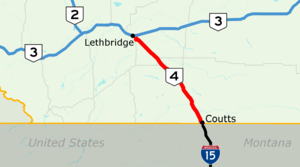| First Special Service Force Memorial Highway | ||||
 Highway 4 highlighted in red | ||||
| Route information | ||||
| Maintained by the Ministry of Transportation and Economic Corridors | ||||
| Length | 103.369 km[1] (64.231 mi) | |||
| History |
| |||
| Major junctions | ||||
| South end | ||||
| ||||
| North end | ||||
| Location | ||||
| Country | Canada | |||
| Province | Alberta | |||
| Specialized and rural municipalities | County of Warner No. 5, Lethbridge County | |||
| Major cities | Lethbridge | |||
| Towns | Milk River | |||
| Villages | Coutts, Warner | |||
| Highway system | ||||
|
| ||||
| ||||

| Location | Volume | |
|---|---|---|
| Coutts | 2,130 | |
| Milk River | 2,530 | |
| Warner | 2,550 | |
| Stirling | 2,490 | |
| Lethbridge | ||
| 20 Ave S | 15,230 | |
| S Parkside Dr | 17,690 | |
| Highway 3 | 15,550 | |
Highway 4 is a 103-kilometre (64 mi) highway in southern Alberta, Canada, that connects Highway 3 in Lethbridge to Interstate 15 in Montana, United States. The highway was designated in 1999 as the First Special Service Force Memorial Highway in honour of elite soldiers who travelled to Helena, Montana, for training before World War II. The highway continues into the United States retaining that name.
It begins in Coutts at Alberta's busiest border crossing, winding north through gentle rolling hills and farmlands in the south of the province. It bypasses Milk River, Warner and Stirling before reaching Lethbridge where it becomes 43 Street and ends at Crowsnest Trail on the east side of the city. In 1995, it was designated as part of the CANAMEX Corridor that links Canada to Mexico and the United States, including the major cities of Salt Lake City, Las Vegas, Los Angeles, and San Diego, which lie on Interstate 15.
Between Lethbridge and Highway 61 near Stirling, Highway 4 is signed as part of the Red Coat Trail, a historic route stretching from southern Alberta into Manitoba that is advertised as approximating the path travelled by the North-West Mounted Police on their quest to the prairies.
The highway began as a trail parallel to a branch of the Canadian Pacific Railway that was built in the late 1800s connecting Lethbridge to Great Falls. It had been named the Sunshine Trail by 1912, and developed into an all-weather gravelled road by the 1930s. Paving and a realignment to eliminate curves was completed by 1947, and in the late 1980s Alberta Transportation announced plans to twin the entire length as part of upgrades to the CANAMEX Corridor south of Calgary that included Highways 2 and 3. An expressway bypass of Milk River completed all work in 2009. A bypass of Lethbridge at the highway's northern terminus is also proposed; it would link Highway 4 to a newly aligned Highway 3 north of the city, making Alberta's portion of the CANAMEX Corridor free-flowing from Coutts to Fort Macleod.
Cite error: There are <ref group=lower-alpha> tags or {{efn}} templates on this page, but the references will not show without a {{reflist|group=lower-alpha}} template or {{notelist}} template (see the help page).
